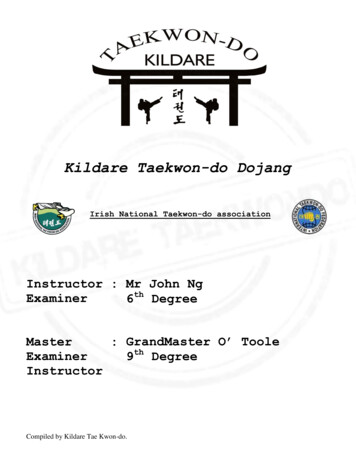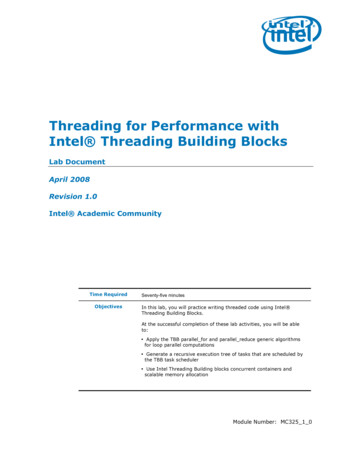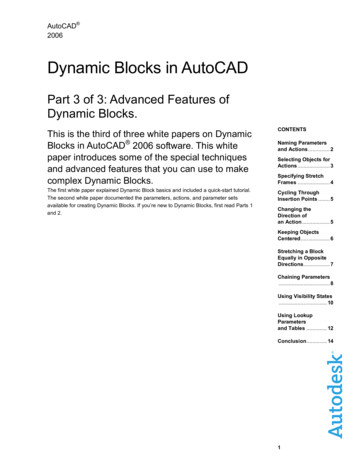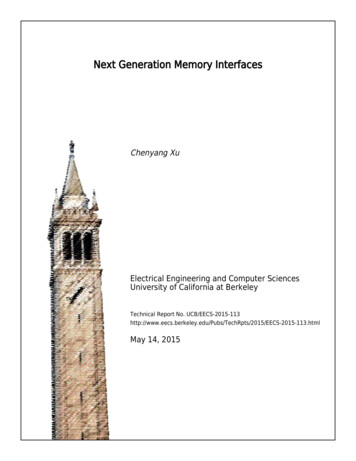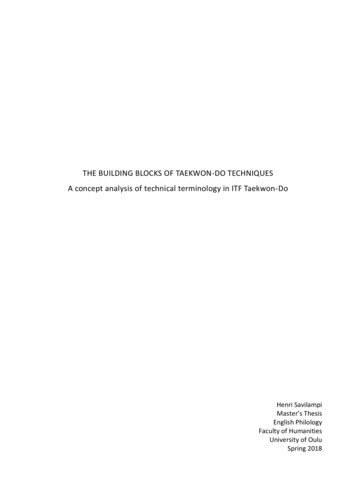
Transcription
THE BUILDING BLOCKS OF TAEKWON-DO TECHNIQUESA concept analysis of technical terminology in ITF Taekwon-DoHenri SavilampiMaster’s ThesisEnglish PhilologyFaculty of HumanitiesUniversity of OuluSpring 2018
TABLE OF CONTENTS1Introduction . 12Theoretical and methodological framework . 42.1Terminology science. 4Language for general purposes and language for specific purposes . 7Object – concept – term . 82.2Practical terminology work . 102.3Concept analysis . 12Concept systems and concept relations . 13Concept analysis step by step . 1734Description of research data . 213.1A brief history of ITF Taekwon-Do. 213.2Encyclopedia of Taekwon-Do. 253.3Composition of ITF Taekwon-Do and its fundamental techniques . 26Analysis: The building blocks of Taekwon-Do techniques. 294.1Stances . 344.2Attacking and blocking tools. 38Hand parts . 39Foot parts . 44Miscellaneous parts . 464.3Technique types . 47Hand technique types . 47Foot technique types . 52Hand-foot combination technique types. 554.4Technique specifications . 56Relative end-position of the attacking or blocking tool . 57Relative direction of the movement . 58Shape and orientation of the tool . 59Purpose of the technique . 60Combination specifications. 61
4.5Other attributes . 64Directions, sides and orientations . 65Height. 68Type of movement. 69Movement rhythm. 725Discussion and conclusion . 75References . 79Appendices . 82
1INTRODUCTIONWe assign names to people and objects in order to distinguish between differentindividuals, between objects with different properties etc. We know immediatelythat “Kim Sun Dal” is not the same person as “Timothy Smith”, that “flora” isdistinct from “fauna”, that a “rock” and a “pillow” do not have identicalcharacteristics. – – Because of names, football can be clearly distinguished frombaseball, Taekwon-Do from Judo. (Choi, 1999, p. 370)The quote above is from Taekwon-Do: The Korean art of self-defence (Choi, 1999), a condensededition of the 15-volume Encyclopedia of Taekwon-Do (Choi, 1985) describing the wholecomposition of the Korean martial art ITF Taekwon-Do. Its founder Choi Hong Hi has on severaloccasions – both in his encyclopedia and elsewhere – emphasized the need for concise terminologyin a modern martial art. (Choi, 1999, p.370; Rhee, 2012, p. 82; Rhee, 2014a; Rhee, 2014b) Thepurpose of this study is to analyze the technical terminology of ITF Taekwon-Do and investigate therelations between the concepts that the terminology is based on. This is achieved by using a methodof terminological research called concept analysis.Terminology science is a field of research investigating the terms and concepts used in languagesfor specific purposes. (Nuopponen & Pilke, 2010, p. 13) The methods of terminology science are alsoapplied into practical terminology work, with a purpose of creating term databases and dictionariesfor specific subject fields to unify the terminology used within the field. (Tekniikan sanastokeskusr.y., 1988, p. 13)Concept analysis is a method used both for terminological research as well as practical terminologywork. It focuses on the distinctive characteristics of each concept, and how the concepts are relatedto each other. (Sanastokeskus TSK ry, 2006, p. 31) Although concept analysis happens constantlyand unconsciously during the human thought process – for example, we understand that forwardand backward are related to each other by antonymy, being opposite of each other – it is sometimesuseful to make it a conscious process to understand the special concepts and terminology withinspecific fields. (Nuopponen, 2003, p. 14)1
A typical end-product of a concept analysis is a concept system, a graphical representation of whichconcepts are related to each other and in which manner. (Tekniikan sanastokeskus r.y., 1988, p. 28)Concept systems are also used in this paper to visualize the analysis of technical terminology in ITFTaekwon-Do. If the method is used for practical terminology work, a concept system may be usedto create a term bank or a dictionary of the subject field. Within terminology science, the conceptsystem itself may be the final product, supplemented by a written analysis explaining the process.Terminology science, practical terminology work and concept analysis are discussed and explainedin more detail in Section 2: Theoretical and methodological framework.The inspiration for this study comes from a similar study conducted by Anita Nuopponen on theterminology of the Japanese chadō tea ceremony. Similarly to this study, Nuopponen conducted aconcept analysis, identifying, grouping and classifying terms and concepts to streamline theJapanese terminology used by chadō enthusiast. (Nuopponen, 2004) As terminology for ITFTaekwon-Do has been developed both in English and Korean, both languages will be present in thisstudy, although the focus will be on the Korean terminology. My plan is to analyze the vast numberof concepts within the martial art to understand which concepts are related to each other and how.Additionally, my research has a more practical purpose, as it aims to provide a comprehensivetechnique naming scheme for the hundreds of fundamental techniques and their variationsperformed in Taekwon-Do.The reason for choosing the terminology of ITF Taekwon-Do as the data for this study stems frommy own interest in the martial art. Having practiced the art since 2002, I have gained anunderstanding of how the Korean terminology behaves and how it is used in the dojang (Korean for‘training hall’). Although there have been several smaller-scale studies on the terminology ofTaekwon-Do (e.g. Banicevich, n.d.), I have never encountered a thorough study on how theterminology – and more specifically, technical terminology – of ITF Taekwon-Do should be used todefine each fundamental technique clearly and unambiguously.My primary objective conducting this research is to remove ambiguity from the technicalterminology and harmonize the word order of technique names by creating a comprehensivetechnique naming scheme, which applies to all techniques in Taekwon-Do. The terminologypresented and analyzed here is based on the data from the Encyclopedia of Taekwon-Do. (Choi,1985; Choi, 1999; see Section 3.2) However, as I do not speak the Korean language nor am I an2
expert in its grammatical structures, wherever additional or replacement terminology is required, Ihave used external sources, such as dictionaries and previous related research, to fill in the gaps.Although some knowledge of the martial art Taekwon-Do and its concepts is necessary to fullyunderstand and appreciate this research, the analysis is written to be comprehensible (albeit notnecessarily of much interest) even for a commoner. Despite this study being heavily related to thetechnical content of ITF Taekwon-Do due to the selection of data, my purpose is not to comment orinstruct on any technical aspects or how the techniques should be performed.In the few instances where the performance is related to the distinct characteristics of each conceptor term, the analysis is based on the information presented in either the Encyclopedia of TaekwonDo or supplemental material produced by the instructors, masters and grandmasters of the art. Thehistory and technical contents of ITF Taekwon-Do, as well as the research data for this study, areintroduced in Section 3.The analysis of the technical terminology in Section 4 is divided into sub-sections according to atechnique naming scheme, a way to name Taekwon-Do techniques. This scheme is based onresearch done by Rhee (2012) and Banicevich (n.d.), although some alterations andsupplementations have been made based on my findings from the research data. The analysisconsists of five sub-sections. The first four, 4.1 Stances, 4.2 Attacking and blocking tools, 4.3Technique types, and 4.4 Technique specifications, are the most common attributes used in thetechnique naming scheme. The fifth sub-section, 4.5 Other attributes, briefly discusses the otherattributes in the scheme which may often be omitted entirely, or used to define variations in thetechniques, such as heights and directions.Finally, at the end of this paper in Section 5, I discuss the results and findings of the analysis, focusingon how Taekwon-Do organizations, instructors and practitioners may benefit from the results. Inaddition, I intend to introduce ideas for possible further research on the terminology of ITFTaekwon-Do, as well as reflect on the whole process of conducting this research.3
2THEORETICAL AND METHODOLOGICAL FRAMEWORKTerminology science is a rather young field of research, with its inception being credited to EugenWüster in the 1930s. (Tekniikan sanastokeskus r.y., 1988, p. 22) In this section, I intend to give anoverview on the research field of terminology science and its history, as well as explain the mostimportant terminology within the field. Then the focus shifts to the practical terminology work andits methods and goals, before finally focusing on the specific method of terminological researchwhich is used in this paper, concept analysis.As any other subject field, terminology science also has its own special language, consisting ofspecial terminology. It is important to make a distinction between the two meanings of the wordterminology: it can refer to a set of designations for concepts in a specific subject field, but also tothe scientific discipline which studies the use and relations of the designations within a subject field.(Sanastokeskus TSK ry, 2006, p. 30) For the sake of clarity, and to avoid any confusion, in this thesisthe research field terminology is referred to as terminology science, whereas terminology refers toa set of terms. In addition, the term terminology work refers to the practical work on terminologywithin a subject field, without a (primary) scientific purpose.2.1Terminology scienceTerminology science is a field of research that investigates and examines the concepts and terms inlanguages for special and specific purposes, i.e. within specific subject fields. (Nuopponen & Pilke,2010, p. 13; Tekniikan sanastokeskus r.y., 1988, p. 22) The history of terminology science started atthe end of the 19th century, when the work on the nomenclature of natural sciences – especiallybiology and chemistry – started. (Tekniikan sanastokeskus r.y., 1988, p. 22) However, the earlyterminological efforts focused mainly on the practical, communicative needs to unify terms withinthe fields. (Nuopponen & Pilke, 2010, p. 13)The first attempts to research terminology scientifically were conducted by the Austrian graduateengineer Eugen Wüster. Wüster is often credited with the inception of terminology science as aresearch domain, and his doctoral dissertation on language standardization in technology (1931) is4
still considered one of the most influential works in terminology science. (Tekniikan sanastokeskusr.y., 1988, p. 13) Wüster established the methods and principles for terminology work andterminology science, building an interdisciplinary field of research. The theories, concepts andmethods of terminology science are based on those in linguistics, philosophy, philosophy of science,semiotics and information technology, modified into a cohesive whole. (Nuopponen & Pilke, 2010,p. 13)Today, terminology is researched extensively around the world. Soon after Wüster’s first efforts,terminological research started in Moscow in the Soviet Union (e.g. Chapyglin & Lotte, 1937), withmany other universities following soon after. The field of terminology science can be divided intodifferent schools based on the methodology and focus points of their research. The differencesbetween schools are, however, rather miniscule, as they are all mostly based on Wüster’s work andhis Vienna School. (Tekniikan sanastokeskus r.y., 1988, pp. 22–23)Two notable schools of terminology science, in addition to Vienna and Moscow mentioned above,are the Prague School (e.g. Drodz, 1981) and the Nordic School (e.g. Nuopponen, 2004). (Cabré &Sager, 1999, pp. 12–13; Tekniikan sanastokeskus r.y., 1988, pp. 22–23) The methodology and focusof this research is based on the framework and traditions of the Nordic School. In the Nordiccountries, the focus of terminological research has been on the practical terminology work. TheNordic languages, having smaller speaker populations in comparison to several other Europeanlanguages, such as English, German and French, have benefitted from the investments the Nordiccountries have made on terminological research. The Nordic School focuses specifically on thepractical terminology work of languages for special purposes. (Nuopponen & Pilke, 2010, pp. 11–12)As terminology science works with the definitions of terms (words), it is also closely related to otherfields of linguistic research. One of these related fields is lexicology, which analyses and describesthe semantic and syntactic relations within the vocabulary (lexicon) of a language. The methods andresults are very similar to those of terminology science. The main difference between the two is thatwhile terminology science investigates the vocabulary in a language for specific purposes, i.e. aspecific subject field, the focus of lexicography is on the language for general purposes, i.e. a formof language not requiring any expert knowledge (see Section 2.1.1). (Alberts, 2001, p. 71;Nuopponen & Pilke, 2010, p. 17) Lexicology is also interested in how the lexical and grammaticalunits are linked together to achieve cohesion within a text. (Halliday & Hasan, 1976, pp. 1–2)5
Although terminology science does not focus particularly on the grammar, it also aims to achievecohesion within a specific subject field, albeit by the means of a unified, consistent andunambiguous set of terms. (Nuopponen & Pilke, 2010, pp. 13–15)The sub-field of lexicology which focuses on the semantic relations is called lexical semantics. Lexicalsemantics studies the meanings of words and the relations between them within a language forgeneral purposes. (Pustejovsky, 1995, p. 1) However, lexical semantics does not work on termbuilding or defining terms for use in languages for special purposes, such as a language variant usedby professionals of the same field. Instead, lexical semantics studies how the words within a lexiconrelate to each other and how the syntax of the language affects the meaning. (Cruse, 1986, p. 1) Theclassification methods of lexical semantics are very similar to those of terminological conceptanalysis and can thus be partially applied. This will be further explored in Section 2.3.1.Previous research in the field of terminology science can be roughly divided into two types: (1)research focusing on further developing methodology for terminological research and practicalterminology work, and (2) research investigating the terminology within a specific subject field inone language or translating it between two (or more) languages. (Nuopponen, 1999, p. 92)While Wüster’s dissertation was a combination of both types – as he had to first develop themethodology for a terminological research before examining the terminology of electricaltechnology – most studies seem to focus on one or the other. (Wüster, 1931) For example, thearticle by Rizzo and Perez (2010) focuses on how new terminology is built for technical English,analysing and explaining the methods of term building.In addition to the research developing the methodology for the discipline, terminological studieshave been conducted on several LSP’s, from animal science (Oprea, 2014) to pension systems(Puttonen, 2000). Some of the research is prescriptive in nature, giving instructions and suggestionson how the terminology could be harmonized within the field, while some is descriptive, focusingon analysing how the terminology is presently used. (Nuopponen, 1999, p. 92)In the following sub-sections, I will introduce the two basic concepts of terminology science: (1) thedifference between a language for general purposes and a language for special purposes, and (2)the relation between object, concept and term. These two concepts are the basis of terminologicalresearch, and more specifically, concept analysis, the methodology of this thesis. Concept analysiswill be further examined in Section 2.3.6
Language for general purposes and language for specific purposesThe first of the two founding pillars of terminology science is the difference between the languagefor general purposes (LGP) and the language for special/specific purposes (LSP). LGP is the form oflanguage, which all members of the language community understand, and it is most often used inour daily communications. LGP’s have long-standing traditions to which new vocabulary anddevelopments of the language automatically adapt. LSP, on the other hand, is a language form usedwithin a specific subject field, outside the domain of common knowledge. Thus, it is onlyunderstandable for professionals of the said field. (Tekniikan sanastokeskus r.y., 1988, p. 11)There are differences in vocabulary as well as idioms and syntax between LGP and LSP’s. LSP’s aretools for the professionals to communicate clearly and unambiguously regarding their commonsubject field. Thus, it is rather important that all speakers of the LSP understand the concepts andterms in the same way. However, the LSP should only diverge from the LGP as little as possible tofulfill the communicative needs of the subject domain. It may be detrimental to an LSP to be toodifficult for outsiders to understand. (Tekniikan sanastokeskus r.y., 1988, pp. 11–12)To fulfill the communicative needs of the professionals without making the LSP too different fromthe LGP, the methods of terminology science can be applied. It is important to keep track of whichterms are used to describe specific concepts, and to dismiss any misfit terms. Practical terminologywork, which consists of systematically collecting, analyzing, describing and presenting terminology,usually results in a term database for the specific subject field, with the goal of standardizing theterminology within the subject field and the LSP. (Sanastokeskus TSK ry, 2006, p. 31; Tekniikansanastokeskus r.y., 1988, p. 13)It should be noted, that there is a distinction between LSP’s and jargons. A jargon is typically a slangform of an LSP, and it should not be used to communicate in a formal context. The stylistic and socialvalue of a jargon is deemed lower than that of an LSP. If possible, the LSP should be developed insuch a way that there is no need for a jargon to make communication easier within the subject field.(Tekniikan sanastokeskus r.y., 1988, p. 12)7
Table 1.LGP (English)Two ITF Taekwon-Do techniques in LGP, LSP and Finnish jargon.a kick performed with the ball of the foot to a targetLSP (Korean ‘English’)Jargon (Finnish)dollyo chagi ‘turning kick’dollariyop chagi ‘side kick’yoppariwith a turning motion from the hipsa kick performed with the outer edge of the foot to atarget in a straight line, with the performer facingsideways in relation to the target at the moment ofimpactTable 1 illustrates the differences between LGP, LSP and jargon, when talking about techniques ofITF Taekwon-Do. This specific jargon used is the one commonly used in Finland in internalcommunications between Taekwon-Do practitioners. It is also noteworthy that the LGP definitionsare simplified, whereas the specifics of the techniques are fully understood by other practitionerswhen using the LSP or the jargon terms.Object – concept – termWithin the field of semiotics, there are various theories which describe how specific words (terms)relate to their meaning and their actual referents. For example, social semiotics define language asa social fact, meaning that it is the culture and the people who use the language who define themeanings, making the meaning a non-verbal agreement. (Halliday, 1978, pp. 1–5) Ogden andRichards, on the other hand, depict meaning-making as a triangular process: a symbol (e.g. a word)symbolizes a thought or reference, which in turn refers to an actual referent. (Ogden & Richards,1985, pp. 8-12)Within the Nordic school of terminology, the semiotic basis for terminological research is usuallythe aforementioned theory by Ogden and Richards. The triangular process is the same, although theterminology used is more specific to the field of research: referent is called object, thought isconcept and symbol is term. This three-way relation between object, concept and term is the secondof the two founding pillars of terminology science. It is often depicted using a modified version of8
the Ogden/Richards triangle, (Tekniikan sanastokeskus r.y., 1988, p. 24) also known as the concepttriangle. (Nuopponen & Pilke, 2010, p. 19)Figure 1.The concept triangle (Tekniikan sanastokeskus r.y., 1988, p. 24)Most people intuitively understand what a concept is and analyze them without understanding themeta-concepts they are actively using. A concept can be simply defined as a mental image.(Nuopponen & Pilke, 2010, p. 18) It can depict anything concrete (e.g. people, animal or items),abstract (e.g. qualities, skills or processes) or imaginary (e.g. fairytale characters). (SanastokeskusTSK ry, 2006, p. 10)For example, when thinking of a chair, everyone has their own mental image of what chairs are likeand how they look. That mental image is the concept of a chair. Having the mental image of a chairmakes it effortless to recognize a chair when seeing one. Thus, the word ‘chair’ is a term, a symbolfor the concept, the mental image we have of the actual object. The dashed line between object andterm in the concept triangle (Figure 1) represents the fact that although the two are linked, theirrelation exists primarily through the concept, not directly. (Nuopponen & Pilke, 2010, pp. 18–19)All concepts can be classified into one of two categories: general concepts or individual concepts.Individual concepts are specific objects, and they are usually symbolized by a proper name, such asMona Lisa. Each individual concept has special characteristics that separate them from others. Thecharacteristics can be internal (e.g. material, shape, size, color and consistency) or external (e.g.location, age, use case and creator). When several individual concepts are brought together, andtheir characteristics are analyzed, the common characteristics make general concepts. For example,Mona Lisa and Vincent van Gogh’s The Starry Night have common characteristics that classify themunder the general concept painting. (Tekniikan sanastokeskus r.y., 1988, pp. 26–27)9
2.2Practical terminology workPractical terminology work refers to applying the methods of terminological research for morepractical purposes, fading out the scientific focus. The most typical example of practical terminologywork is a project to create a dictionary or a term database on a specific subject field. (Nykänen,1999b, p. 62) In this section, I intend to give a brief overview on the methods, steps and results oftypical terminology projects. This overview is based on the projects conducted in the Finnish centerfor terminology, Sanastokeskus TSK ry. While methods may vary between projects and especiallybetween coordinating organizations, the main phases introduced here should provide a generalunderstanding of how a terminology project progresses.Nykänen (1999b, p. 68) divides a terminology project into six main phases: (1) planning, (2) starting,(3) formulation, (4) feedback, (5) finalization, and (6) follow-up. Although these phases arepresented here as a linear process, they often overlap each other during actual projects, and somephases may even have to be repeated. For example, the project may have to return to formulationphase after the feedback phase, if large-scale alterations are necessary for the quality of the finalproduct. (Nykänen, 1999b, pp. 67–68)The first phase, planning, which is done before the project properly starts, consists of an inquiry ofdemand, setting the goals, devising a project plan, and financial planning. (Nykänen, 1999b, p. 63)As a terminology project should always emerge from practical needs, the experts of the field inquestion should be interviewed to understand their requirements and to set clear and concise goalsfor the project. The needs and goals become a starting point for the project plan. Additionally, theproject plan should describe the methods and resource requirements, schedules and deadlines, andwhere and in what format the resulting dictionary will be released. Finally, before properlybeginning the project, it needs financial planning. The projects conducted in Sanastokeskus TSK inFinland are usually financed by companies and other organizations from the field in question.(Nykänen, 1999b, pp. 63–64)After the project plan is approved, the project moves to the starting phase. At this point, a projectteam led by a project manager is appointed. Not all members of the team are necessarilyterminologists, as experts from the subject field are also vital to the success of the project. Despitethat, all members must be at least in some way familiar with the methods and tools of a terminology10
project. If necessary, the subject field experts are given an intensive course on terminology work.Additionally, the project plan is revised at this phase, with specific responsibilities appointed to eachmember of the team. (Nykänen, 1999b, pp. 64–65)The third phase, formulation, consists of the actual work with the terminology of the subject field.It is the most time-consuming of the phases, with Nykänen attributing almost half of the totalworkload to this phase. (Nykänen, 1999b, p. 66) The formulation phase usually begins by collectingpre-terms from literary works of the subject field. Pre-terms may be any words or phrases thatappear in texts about the subject field that look like they could be field-related terminology. Thereare usually 2–4 times more pre-terms than there are terms in the final product. Alternatively, theformulation may begin by selecting a small number of the most vital concepts and starting to buildthe terminology around them. (Nykänen, 1999b, p. 65) The latter method more closely resemblesthe one used in this thesis, as the collection of
Taekwon-Do has been developed both in English and Korean, both languages will be present in this study, although the focus will be on the Korean terminology. My plan is to analyze the vast number of concepts within the martial art to understand which concepts are related to each other and how.


